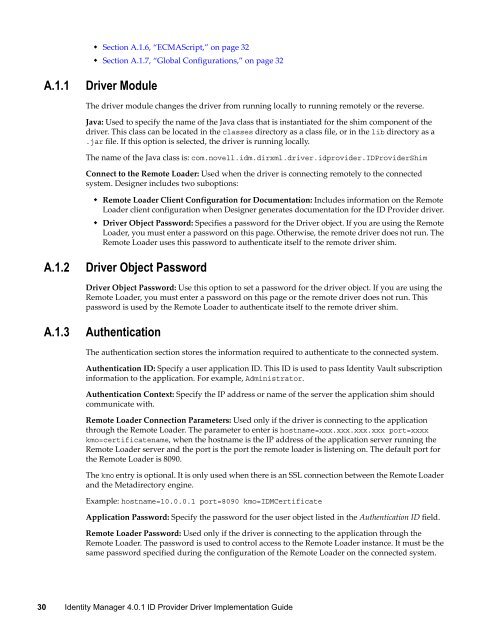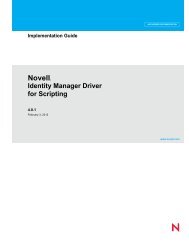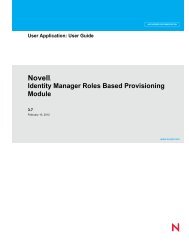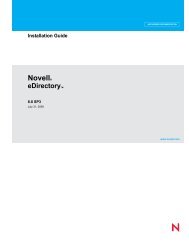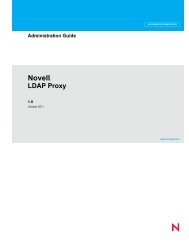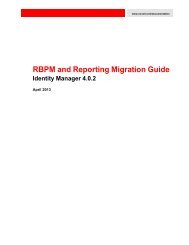Identity Manager 4.0.1 ID Provider Driver Implementation ... - NetIQ
Identity Manager 4.0.1 ID Provider Driver Implementation ... - NetIQ
Identity Manager 4.0.1 ID Provider Driver Implementation ... - NetIQ
You also want an ePaper? Increase the reach of your titles
YUMPU automatically turns print PDFs into web optimized ePapers that Google loves.
• Section A.1.6, “ECMAScript,” on page 32<br />
• Section A.1.7, “Global Configurations,” on page 32<br />
A.1.1<br />
<strong>Driver</strong> Module<br />
The driver module changes the driver from running locally to running remotely or the reverse.<br />
Java: Used to specify the name of the Java class that is instantiated for the shim component of the<br />
driver. This class can be located in the classes directory as a class file, or in the lib directory as a<br />
.jar file. If this option is selected, the driver is running locally.<br />
The name of the Java class is: com.novell.idm.dirxml.driver.idprovider.<strong>ID</strong><strong>Provider</strong>Shim<br />
Connect to the Remote Loader: Used when the driver is connecting remotely to the connected<br />
system. Designer includes two suboptions:<br />
• Remote Loader Client Configuration for Documentation: Includes information on the Remote<br />
Loader client configuration when Designer generates documentation for the <strong>ID</strong> <strong>Provider</strong> driver.<br />
• <strong>Driver</strong> Object Password: Specifies a password for the <strong>Driver</strong> object. If you are using the Remote<br />
Loader, you must enter a password on this page. Otherwise, the remote driver does not run. The<br />
Remote Loader uses this password to authenticate itself to the remote driver shim.<br />
A.1.2<br />
<strong>Driver</strong> Object Password<br />
<strong>Driver</strong> Object Password: Use this option to set a password for the driver object. If you are using the<br />
Remote Loader, you must enter a password on this page or the remote driver does not run. This<br />
password is used by the Remote Loader to authenticate itself to the remote driver shim.<br />
A.1.3<br />
Authentication<br />
The authentication section stores the information required to authenticate to the connected system.<br />
Authentication <strong>ID</strong>: Specify a user application <strong>ID</strong>. This <strong>ID</strong> is used to pass <strong>Identity</strong> Vault subscription<br />
information to the application. For example, Administrator.<br />
Authentication Context: Specify the IP address or name of the server the application shim should<br />
communicate with.<br />
Remote Loader Connection Parameters: Used only if the driver is connecting to the application<br />
through the Remote Loader. The parameter to enter is hostname=xxx.xxx.xxx.xxx port=xxxx<br />
kmo=certificatename, when the hostname is the IP address of the application server running the<br />
Remote Loader server and the port is the port the remote loader is listening on. The default port for<br />
the Remote Loader is 8090.<br />
The kmo entry is optional. It is only used when there is an SSL connection between the Remote Loader<br />
and the Metadirectory engine.<br />
Example: hostname=10.0.0.1 port=8090 kmo=<strong>ID</strong>MCertificate<br />
Application Password: Specify the password for the user object listed in the Authentication <strong>ID</strong> field.<br />
Remote Loader Password: Used only if the driver is connecting to the application through the<br />
Remote Loader. The password is used to control access to the Remote Loader instance. It must be the<br />
same password specified during the configuration of the Remote Loader on the connected system.<br />
30 <strong>Identity</strong> <strong>Manager</strong> <strong>4.0.1</strong> <strong>ID</strong> <strong>Provider</strong> <strong>Driver</strong> <strong>Implementation</strong> Guide


